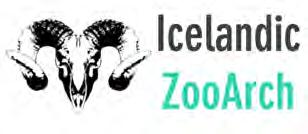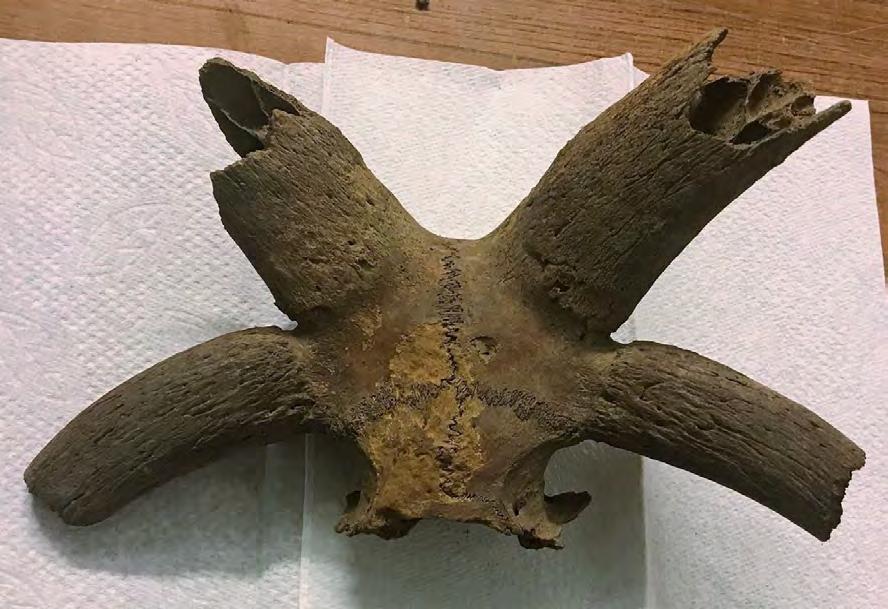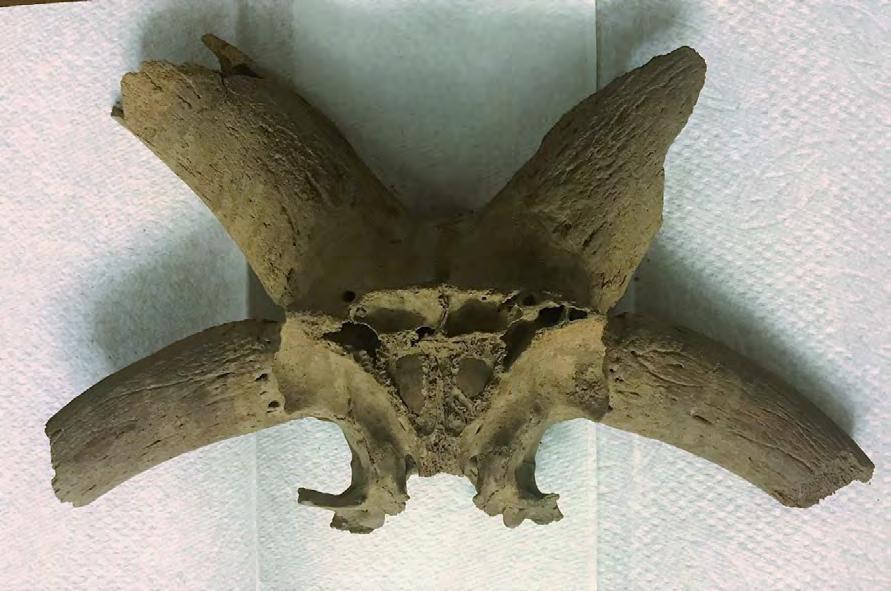Rit







978-9979-881-94-0
© Albína Hulda Pálsdóttir, Sanne Boessenkool, Agricultural University of Iceland & IcelandicZooArch
Sheep and Goat Skulls from Follobanen Bispegata Oslo, Norway: Ancient DNA Sampling Report
LbhÍ nr. 123
Publisher: Agricultural University of Iceland (Landbúnaðarháskóli Íslands)
Place: Reykjavík
1670 5785
978 9979 881 94
Picture on front page: Four horned sheep skull (SL 8424) from Follobanen after sampling. Photo: Agata Gondek.
Figure 1: The goat skull from layer 16236 in the original bag. Photo: Albína Hulda Pálsdóttir. 7
Figure 2: Goat skull from layer 16236, the 90° angle between the coronal and frontal sutures which is charactersitic for goats (Boessneck, 1969, pp. 332–333) is clearly visible. Photo: Albína Hulda Pálsdóttir. 7
Figure 3: The goat skull from layer 16236 with the petrous bone visible. Photo: Albína Hulda Pálsdóttir. 8
Figure 4: The sheep/goat skull from layer 80263 in the original bag. Photo: Albína Hulda Pálsdóttir. 9
Figure 5: The sheep/goat skull from layer 80263 which was likely chopped in half. Photo: Albína Hulda Pálsdóttir. 9
Figure 6: Goat (Capra hircus) skull with petrous bone from layer 16004 in original bag. Photo: Albína Hulda Pálsdóttir.
10
Figure 7: Goat skull from layer 16004 with petrous bone visible, the petrous bone can clearly be identified as goat (Capra hircus). Photo by Agata Gondek. 11
Figure 8: Goat (Capra hircus) skull with petrous bone from layer 16004, horn cores have been removed. Photo: Albína Hulda Pálsdóttir. 11
Figure 9: Goat (Capra hircus) skull with petrous bone from layer 16004 which has been chopped through the occipital region. Photo: Albína Hulda Pálsdóttir. 12
Figure 10: Goat (Capra hircus) skull from layer 16004 in original bag. Photo: Albína Hulda Pálsdóttir. 13
Figure 11: Goat (Capra hircus) skull from layer 16004 with horn cores removed, the 90° angle between the coronal and frontal sutures which is charactersitic for goats (Boessneck, 1969, pp. 332–333) is clearly visible. Photo: Albína Hulda Pálsdóttir. 14
Figure 12: Goat (Capra hircus) skull from layer 16004 chopped through the braincase and occipital region. Photo: Albína Hulda Pálsdóttir. 14
Figure 13: Photo of the four horned sheep skull from layer 8424 with context information. Photo by: Agata Gondek.
15
Figure 14: Four horned sheep skull VSH083 before sampling. Top view. Photo by Giada Ferrari. ........ 16
Figure 15: Four horned sheep skull VSH083 before sampling. Bottom view. Photo by Giada Ferrari. 16
Figure 16: Measurments of the four horned sheep skull. Drawing by Agata Gondek. 17
Figure 17: Four horned sheep skull (VSH083) after sampling for aDNA. Scale 10 cm. Photo by Agata Gondek. 18
Figure 18: Results from Bioanalyzer 2100 (Agilent) for sample VSH083. The sample had little DNA and was therefore not selected for screening. 19
Table 1: Full information on all the skulls from Follobanen Bispegata considered for ancient DNA analysis.
Table 2: Measurements in mm of the four horned skull (VSH083) following von den Driesch (1976, pp. 27–30).
Five partial caprine skulls from the excavation in Follobanen Bispegata in Oslo (Berge, Ødeby, Holmen, Derrick, & Helstad, In prep) were given to us for possible ancient DNA sampling as part of the project “The Horses and Sheep of the Vikings: Archaeogenomics of Domesticates in the North Atlantic Research”. Only two of the skulls had a petrous bone which is preferred for sampling for ancient DNA as it often has excellent DNA preservation (Hansen et al., 2017; Pinhasi et al., 2015). Since the focus of the project was acquiring ancient DNA samples from sheep (Ovis aries) skulls from goats (Capra hircus, see below) were not sampled even if the petrous bone was present. Full information on the skulls can be found in Table 1.
Skulls were identified to species by zooarchaeologist Albína Hulda Pálsdóttir. Identification was done with the aid of reference manuals, Boessneck (1969) for skull structure and suture shape, and petrous bones were identified to species following Mallet & Guadelli (2013). Species identification based on petrous bone shape for sheep and goat is quite reliable when done by people with experience (pers. obs. Albína Hulda Pálsdóttir).
Table 1: Full information on all the skulls from Follobanen Bispegata considered for ancient DNA analysis.
Follobanen 16236 15.3.2018 Goat Nearly complete skull with petrous bone.
Wasteheap, bygård
Follobanen 16004 13.3.2018 Goat Nearly complete skull Possible levelling layer under a building secondary deposit
Follobanen 16004 13.3.2018 Goat Partial skull, no petrous bone. Possible levelling layer under a building secondary deposit
Follobanen 80236 Unknown Sheep/goat Partial skull, no petrous bone. Built up layers (probably dumped‐ secondary deposit)
Follobanen 8424 5.10.2017 Sheep Four horned skull Refuse layers (possible primary refuse)
Late 1100 to early 1200 Brain case broken, possible butchery.
No, wrong species.
1200 1300 Horn cores removed, chopped through occipital region. No, wrong species.
1200 1300 Horn cores have been removed and the skull chopped through the brain case and the occipital region.
1100 1200 Possibly chopped in half. Very small skull.
1150 1350 Top of the skull with the horn cores seems to have been chopped.
No, wrong species.
No petrous bone present.
Yes, sheep and unusual trait, four horned.
Nearly complete goat skull from layer 16236
The goat (Capra hircus) skull from layer 16236 (Figure 1) is nearly complete. The skull can be clearly identified as goat based on the angle between the coronal and frontal sutrues following Boessneck (1969, pp. 332–333) (Figure 2) as well as on the shape of the petrous bone following Mallet & Guadelli (2013) (Figure 3).
Figure 2: Goat skull from layer 16236, the 90° angle between the coronal and frontal sutures which is charactersitic for goats (Boessneck, 1969, pp. 332–333) is clearly visible. Photo: Albína Hulda Pálsdóttir.
Partial sheep/goat skull from layer 80236
The partial sheep/goat skull from layer 80236 (Figure 4) did not include the petrous bone and could not be clearly identified as sheep or goat. It has likely been chopped in half. It is possible the individual was still a juvenile as the skull was quite small and delicate. The individual was naturally polled.
The two skulls from layer 16004
There were two partial skulls from layer 16004, both from goats. One had the petrous bone intact but the other did not.
Goat skull with petrous bone from layer 16004
The first skull from layer 16004 (Figure 6) had a petrous bone and can be identified as a goat (Capra hircus) based on its shape (Figure 7) following Mallet & Guadelli (2013). The horn cores have been removed from the skull, presumably the horn was used for craft working (Figure 8). The skull has also been chopped through occipital region (Figure 12).

Goat skull without petrous bone from layer 16004
The second skull from layer 16004 (Figure 10) did not have a petrous bone. The skull can be identified as goat based on the cranial sutures (Boessneck, 1969). The horn cores seem to have been intentionally removed from the skull (Figure 11), possibly the horns were used as raw material from some craft work. The skull has clearly been chopped through both the occipital and brain case (Figure 12).
Figure 11: Goat (Capra hircus) skull from layer 16004 with horn cores removed, the 90° angle between the coronal and frontal sutures which is charactersitic for goats (Boessneck, 1969, pp. 332–333) is clearly visible. Photo: Albína Hulda Pálsdóttir.
Figure 12: Goat (Capra hircus) skull from layer 16004 chopped through the braincase and occipital region. Photo: Albína Hulda Pálsdóttir.
The only skull sampled for ancient DNA from the Follobanen Bispegata was the four horned sheep skull from layer 8242 (Figure 13). Unfortunately, only the very top part of the skull was present so there was no petrous bone to sample. Despite that we decided to attempt to cut a small sample from the base of one of the four horn cores to get an ancient DNA sample (Figure 17). Four horned skulls are rare in the archaeological record (Daróczi Szabó & Daróczi Szabó, 2018; Putelat, 2006) and it would have been very interesting to get ancient DNA from such an unusual individual.
The four horned skull seems to have been intentionally chopped to keep the four horns together and it seems likely that the skull was on display before being discarded. The skull is therefore a rather unusual artefact as well as an interesting zooarchaeological specimen.


with


All DNA extraction and pre PCR library protocols were performed in the dedicated ancient DNA laboratory at the Department of Biosciences, University of Oslo following strict aDNA precautions (Allentoft et al., 2012; Cooper & Poinar, 2000). Laboratory protocols, data processing and filtering are described in Star et al. (2018). In short, after UV expose on all sides, samples were milled using a custom designed stainless steel mortar (Gondek, Boessenkool, & Star, 2018). Extraction used a combined bleach and pre digestion protocol (Boessenkool et al., 2016). Specifically, bleach washes were performed in duplicate (150 200 mg of powder each) (Boessenkool et al., 2016), washed with H2O and pre digested, which was followed by an overnight, second digestion (Gamba et al., 2015). The two eluates were concentrated (Amicon 30kDA Centrifugal Filter Units) after the overnight digestion and combined, extracting DNA using Minelute (Qiagen) according to manufacturer’s instructions. Using 60 μl pre heated (60°C) EB buffer, DNA was eluted by incubating for 15 min at 37°C (Star et al., 2014). After this, blunt end Illumina libraries were built (Meyer & Kircher, 2010; Schroeder et al., 2015) and library quality was assessed using a Bioanalyzer 2100 (Agilent).
Unfortunately, the DNA libraries from the four horned sheep skull (VSH083, 8424) did not yield sufficient DNA preservation for further analyses within this study (Figure 18). It would be possible to

amplify the sample to get a mitochondrial genome but there is very little geographical or temporal structure in the mitochondrial genomes of European sheep (Hiendleder, Lewalski, Wassmuth, & Janke, 1998; Niemi et al., 2013; Rannamäe et al., 2016; Tapio, 2006) so this would yield very little information. Therefore, it was decided not to process the sample further at this time.

This small sample of the archaeofauna from the Follobanen excavation is very interesting. The number of goat skulls was rather unexpected but would make sense as goats seem to have been preferred to sheep in urban areas as they can be milked for much longer periods of time and have more omnivorous diets than sheep and their horns and skins were popular raw material for craft working (e.g. Lie, 1988; Noddle, 1994; Salvagno & Albarella, 2019). The butchery patterns observed are also interesting and certainly show that there is lot of interesting information to be found in the archaeofauna from the site with traditional zooarchaeological analysis.
Following recommendations in Pálsdóttir et al. (2019) all unsampled bone and the four horned sheep skull that was sampled were returned to NIKU. Bone powder and DNA extracts and other sample products from sample VSH083 will be kept in the CEES, UiO, ancient DNA laboratory and will be accessible to other researchers once the current project is completed.
The zooarchaeological analysis and ancient DNA analysis of the samples from Follobanen was undertaken as part of the project “The Horses and Sheep of the Vikings: Archaeogenomics of Domesticates in the North Atlantic Research” funded by the Icelandic Research Fund 2016 2019. Grant No. 162783 051.
We acknowledge Agata Gondek, CEES, UiO for the photographs of the samples as well as lab work performed. Giada Ferrari CEES, UiO on advice on sampling the four horned skull. For samples from the Follobanen excavation in Oslo we acknowledge Tone Bergland and Håvard Hegdal.
Allentoft, M. E., Collins, M., Harker, D., Haile, J., Oskam, C. L., Hale, M. L., Bunce, M. (2012). The half life of DNA in bone: Measuring decay kinetics in 158 dated fossils. Proceedings of the Royal Society of London B: Biological Sciences, 279(1748), 4724–4733. https://doi.org/10.1098/rspb.2012.1745
Berge, S. L., Ødeby, K., Holmen, K. O., Derrick, M., & Helstad, M. (In prep). Follobanen Bispegata. Arkeologisk utgravning under Bispegata, Gamlebyen, Oslo [NIKU Rapport]. Oslo: Norsk institutt for kulturminneforskning.
Boessenkool, S., Hanghøj, K., Nistelberger, H. M., Der Sarkissian, C., Gondek, A. T., Orlando, L., … Star, B. (2016). Combining bleach and mild predigestion improves ancient DNA recovery from bones. Molecular Ecology Resources https://doi.org/10.1111/1755 0998.12623
Boessneck, J. (1969). Osteological Differences between Sheep (Ovis aries Linné) and Goat (Capra hircus Linné). In Science in Archaeology: A Survey of Progress and Research (pp. 331–358). New York: Prager Publishers.
Cooper, A., & Poinar, H. N. (2000). Ancient DNA: Do It Right or Not at All. Science, 289(5482), 1139b–11139. https://doi.org/10.1126/science.289.5482.1139b
Daróczi Szabó, M., & Daróczi Szabó, L. (2018). 16. Medieval Multi Horned Sheep from Present Day Budapest, Hungary. In L. Bartosiewicz & E. Gál (Eds.), Care or neglect?: Evidence of animal disease in archaeology: Proceedings of the 6th meeting of the Animal Palaeopathology Working Group of the International Council for Archaeozoology (ICAZ), Budapest, Hungary, 2016 (pp. 247–255). Oxford ; Philadelphia: Oxbow Books.
Gamba, C., Hanghøj, K., Gaunitz, C., Alfarhan, A. H., Alquraishi, S. A., Al Rasheid, K. A. S., Orlando, L. (2015). Comparing the performance of three ancient DNA extraction methods for high throughput sequencing. Molecular Ecology Resources, n/a n/a. https://doi.org/10.1111/1755 0998.12470
Gondek, A. T., Boessenkool, S., & Star, B. (2018). A stainless steel mortar, pestle and sleeve design for the efficient fragmentation of ancient bone https://doi.org/10.1101/265587
Hansen, H. B., Damgaard, P. B., Margaryan, A., Stenderup, J., Lynnerup, N., Willerslev, E., & Allentoft, M. E. (2017). Comparing Ancient DNA Preservation in Petrous Bone and Tooth Cementum. PLOS ONE, 12(1), e0170940. https://doi.org/10.1371/journal.pone.0170940 Hiendleder, S., Lewalski, H., Wassmuth, R., & Janke, A. (1998). The Complete Mitochondrial DNA
Sequence of the Domestic Sheep (Ovis aries) and Comparison with the Other Major Ovine Haplotype. Journal of Molecular Evolution, 47(4), 441–448. https://doi.org/10.1007/PL00006401
Lie, R. W. (1988). Animal bones. In E. Schia (Ed.), De arkeologiske utgravninger i Gamlebyen, Oslo. Bind 5: Mindets Tomt—Søndre Felt (pp. 153–195).
Mallett, C., & Guadelli, J. L. (2013). Distinctive features of Ovis aries and Capra hircus petrosal parts of temporal bone: Applications of the features to the distinction of some other Caprinae (Capra ibex, Rupicapra rupicapra). PALEO Revue D’Arcahélogie Préhistorique, 24, 173–191.
Meyer, M., & Kircher, M. (2010). Illumina Sequencing Library Preparation for Highly Multiplexed Target Capture and Sequencing. Cold Spring Harbor Protocols, 2010(6), pdb.prot5448. https://doi.org/10.1101/pdb.prot5448
Niemi, M., Bläuer, A., Iso Touru, T., Nyström, V., Harjula, J., Taavitsainen, J. P., Kantanen, J. (2013). Mitochondrial DNA and Y chromosomal diversity in ancient populations of domestic sheep (Ovis aries) in Finland: Comparison with contemporary sheep breeds. Genetics Selection Evolution, 45(1), 2. https://doi.org/10.1186/1297 9686 45 2
Noddle, B. (1994). The under rated goat. In Urban rural connexions; perspectives from environmental archaeology (pp. 117–128). Oxford.
Pálsdóttir, A. H., Bläuer, A., Rannamäe, E., Boessenkool, S., & Hallsson, J. H. (2019). Not a limitless resource: Ethics and guidelines for destructive sampling of archaeofaunal remains. Royal Society Open Science, 6(10), 191059. https://doi.org/10.1098/rsos.191059
Pinhasi, R., Fernandes, D., Sirak, K., Novak, M., Connell, S., Alpaslan Roodenberg, S., … Hofreiter, M. (2015). Optimal Ancient DNA Yields from the Inner Ear Part of the Human Petrous Bone. PLOS ONE, 10(6), e0129102. https://doi.org/10.1371/journal.pone.0129102
Putelat, O. (2006). Poster: Early Middle Age and polycerate sheep Presented at the ICAZ 2006. International Conference. Exploitation of Coastal Resourses : New and Old World Perspectives.
Rannamäe, E., Lõugas, L., Speller, C. F., Valk, H., Maldre, L., Wilczyński, J., Saarma, U. (2016). Three Thousand Years of Continuity in the Maternal Lineages of Ancient Sheep (Ovis aries) in Estonia. PLOS ONE, 11(10), e0163676. https://doi.org/10.1371/journal.pone.0163676
Salvagno, L., & Albarella, U. (2019). Was the English medieval goat genuinely rare? A new morphometric approach provides the answer. Archaeological and Anthropological Sciences. https://doi.org/10.1007/s12520 019 00843 2
Schroeder, H., Ávila Arcos, M. C., Malaspinas, A. S., Poznik, G. D., Sandoval Velasco, M., Carpenter, M. L., Gilbert, M. T. P. (2015). Genome wide ancestry of 17th century enslaved Africans from the Caribbean. Proceedings of the National Academy of Sciences, 201421784. https://doi.org/10.1073/pnas.1421784112
Star, B., Barrett, J. H., Gondek, A. T., & Boessenkool, S. (2018). Ancient DNA reveals the chronology of walrus ivory trade from Norse Greenland. BioRxiv https://doi.org/10.1101/289165
Star, B., Nederbragt, A. J., Hansen, M. H. S., Skage, M., Gilfillan, G. D., Bradbury, I. R., Jentoft, S. (2014). Palindromic Sequence Artifacts Generated during Next Generation Sequencing Library
Preparation from Historic and Ancient DNA. PLoS ONE, 9(3), e89676. https://doi.org/10.1371/journal.pone.0089676
Tapio, M. (2006). Origin and maintenance of genetic diversity in Northern European sheep (PhD Thesis). University of Oulu, Oulu.
von den Driesch, A. (1976). A Guide to the Measurement of Animal Bones from Archaeological Sites (Vol. 1). Cambridge: Peabody Museum of Archaeology and Etnhology, Harvard University.